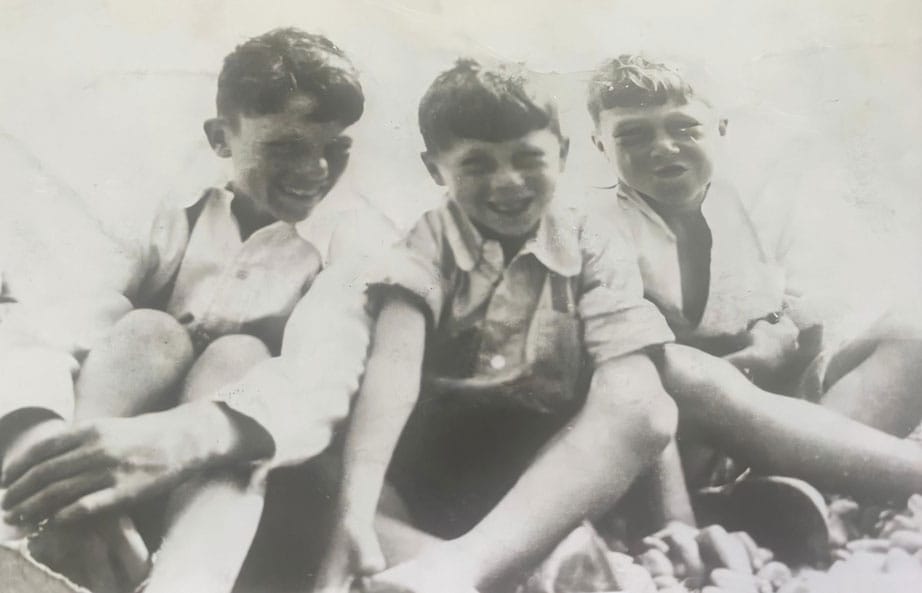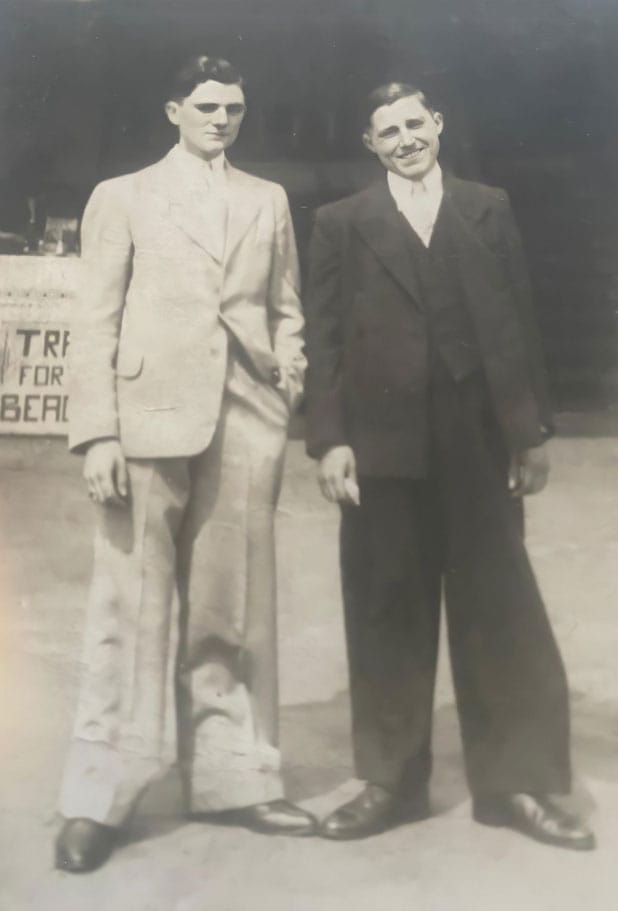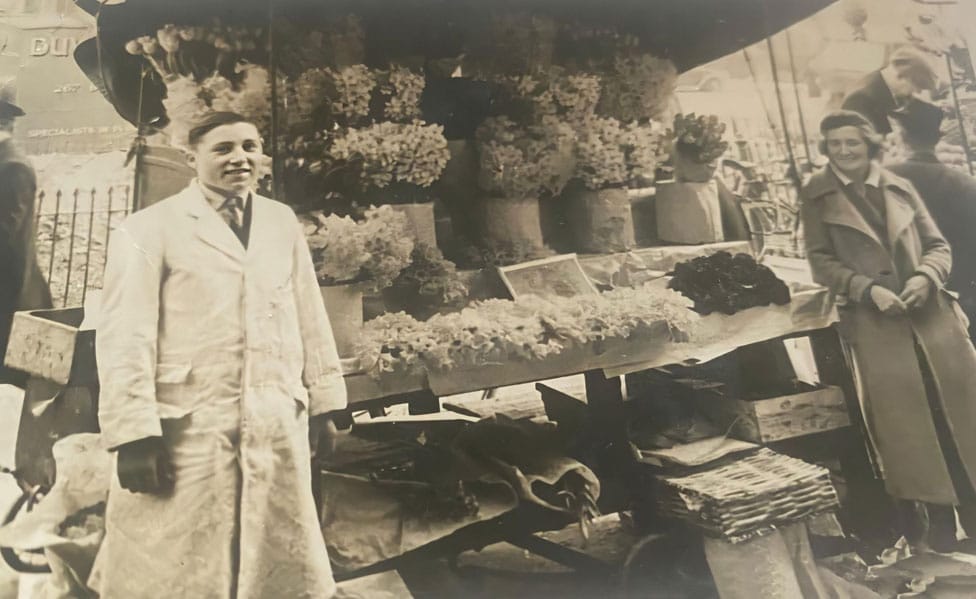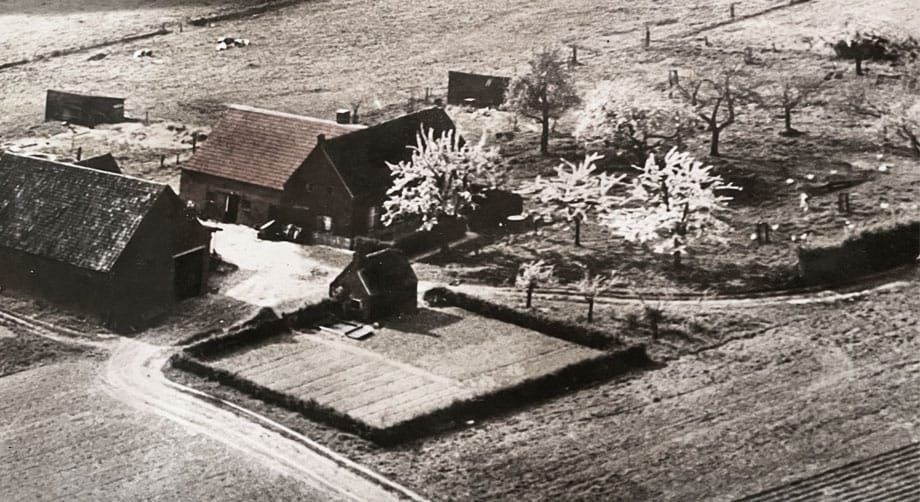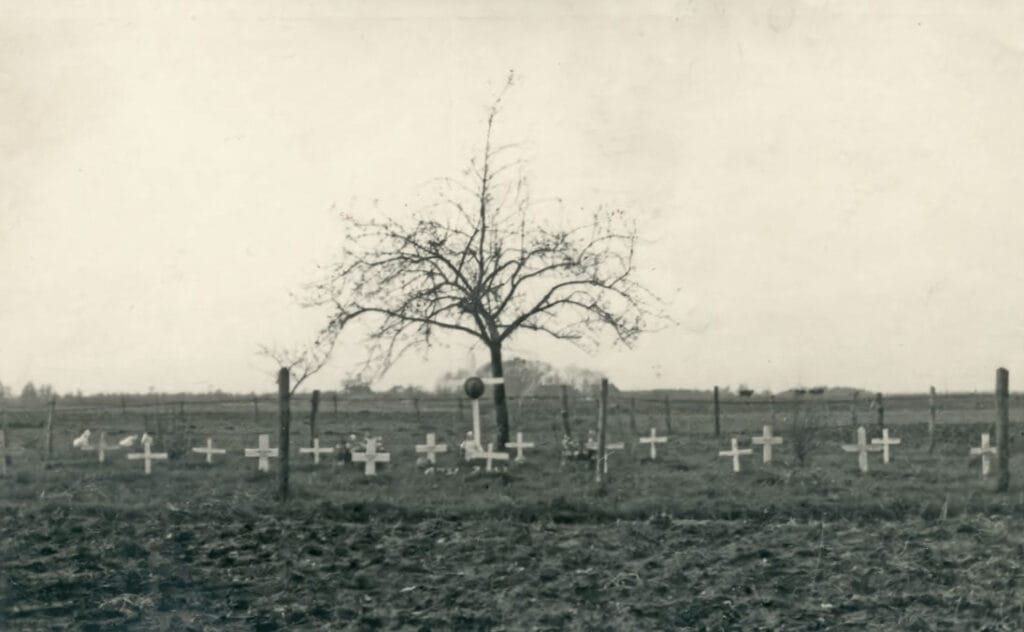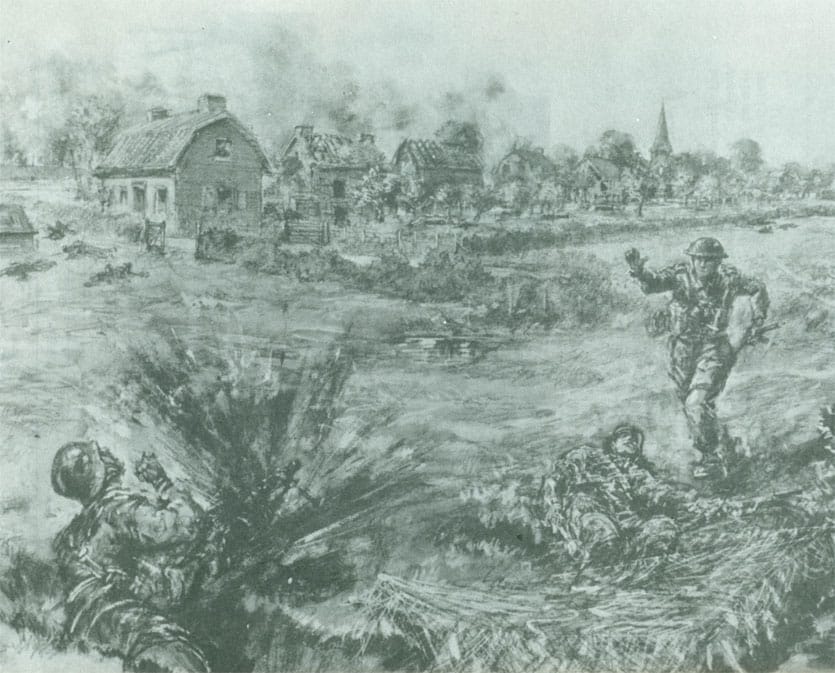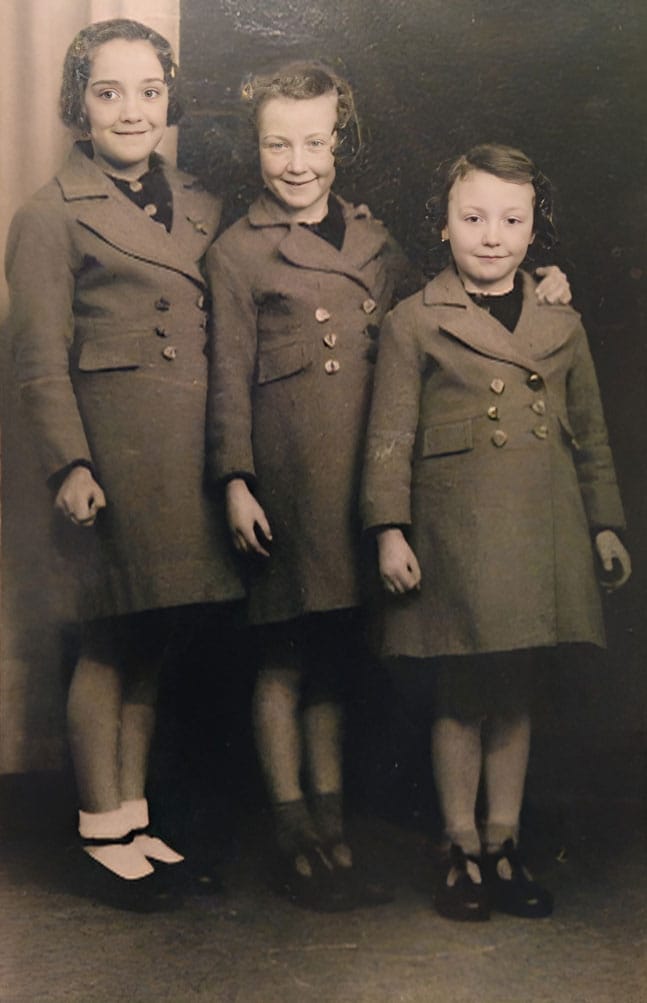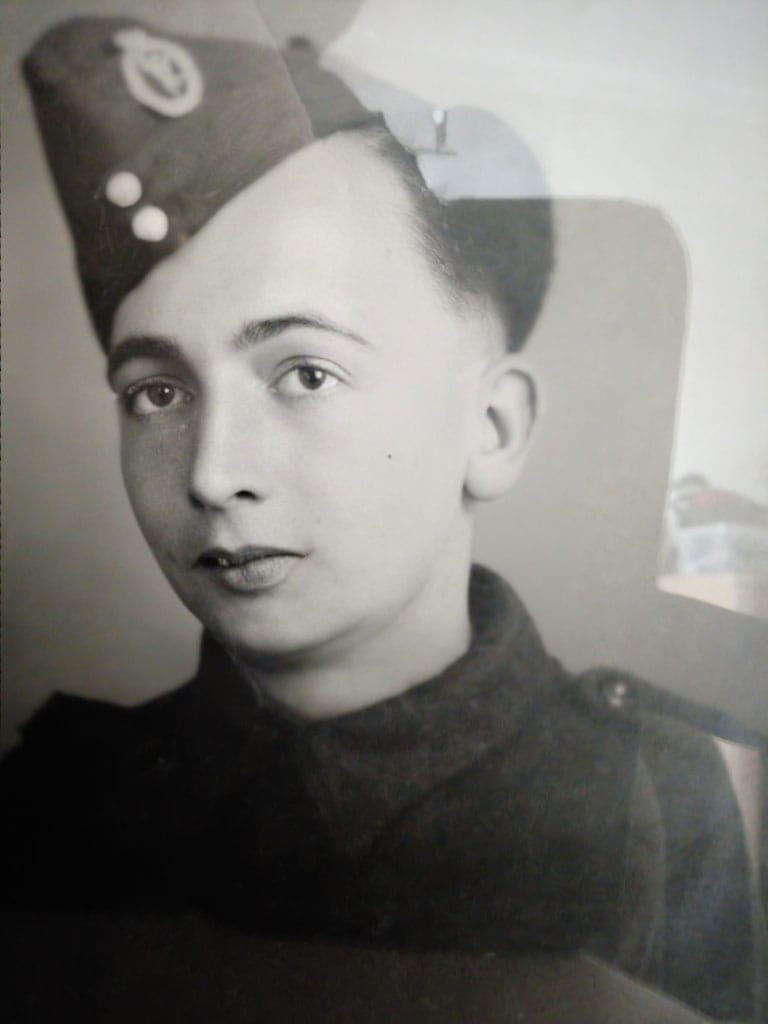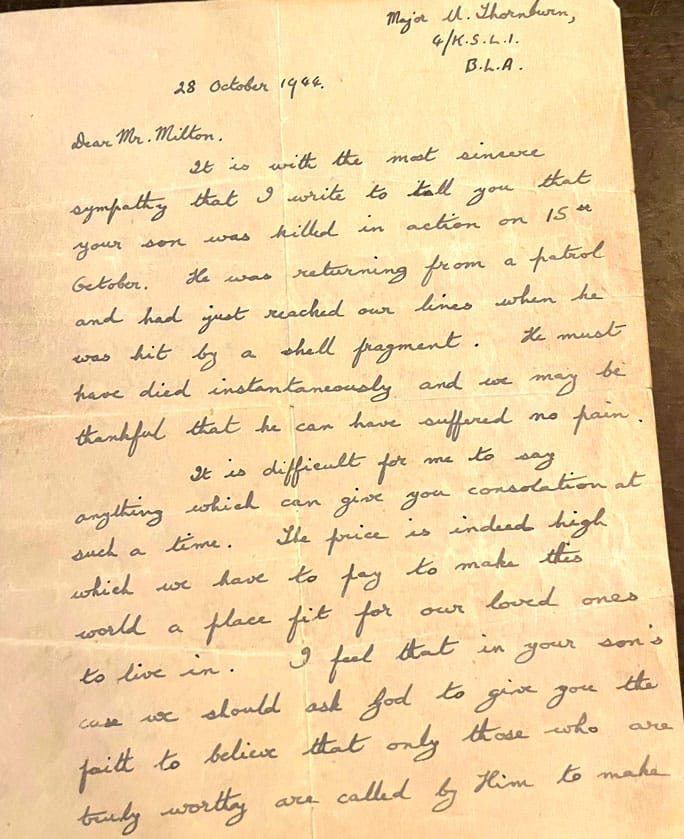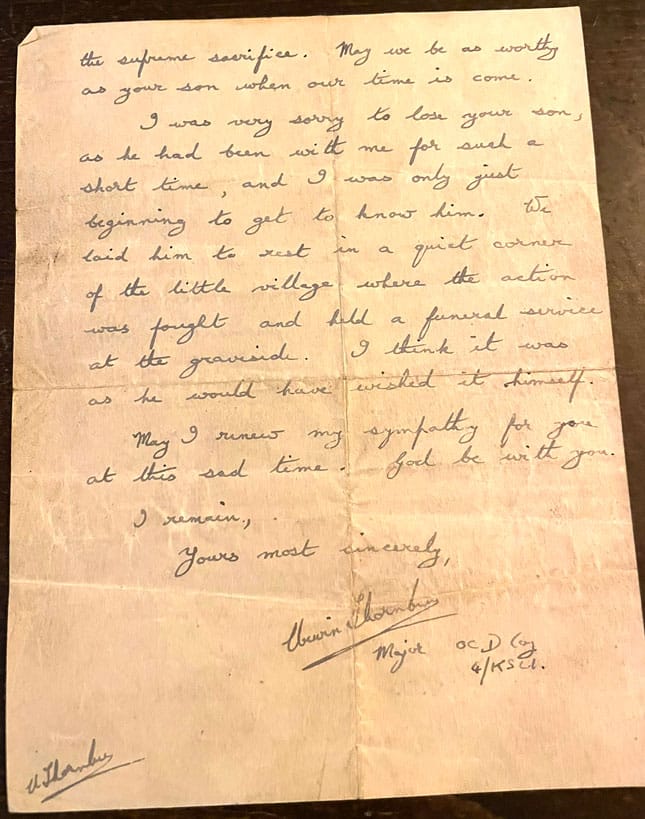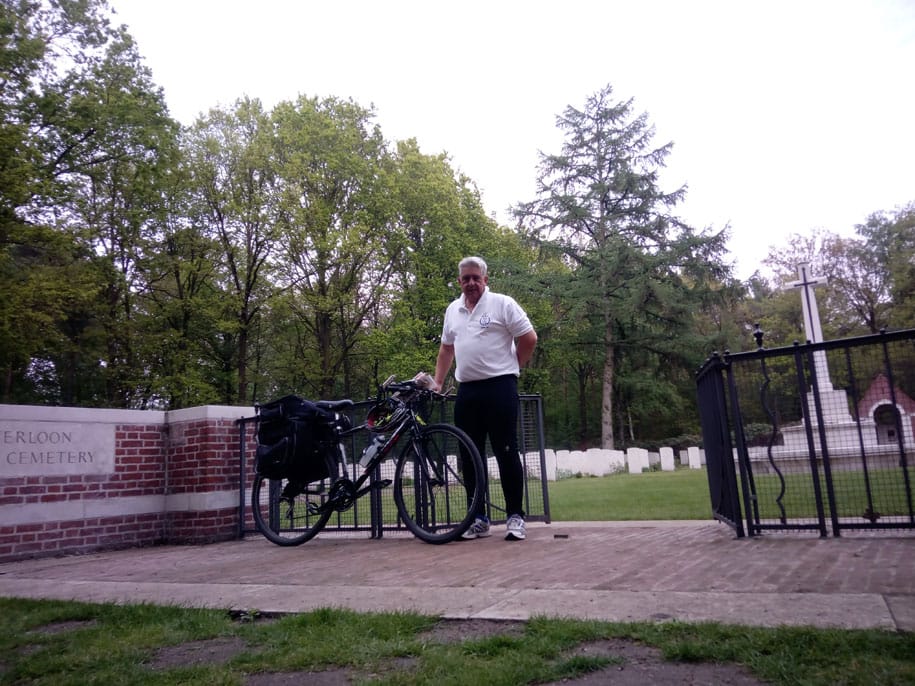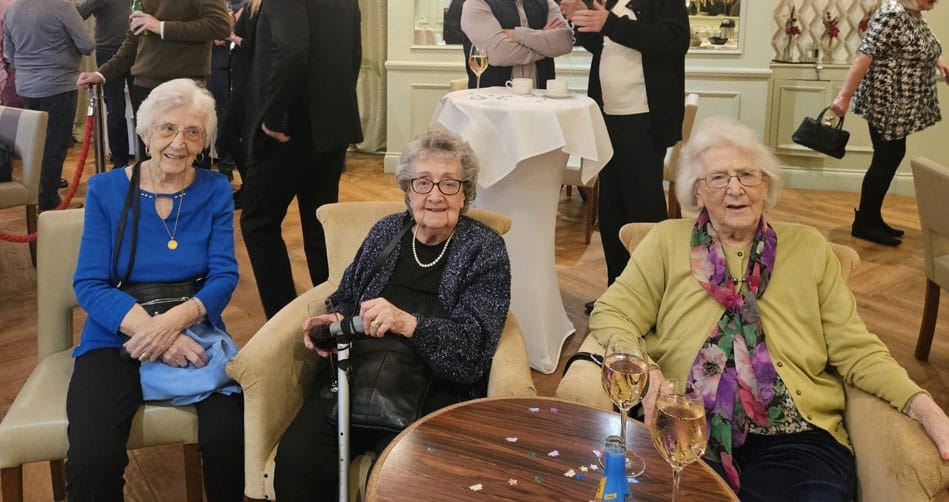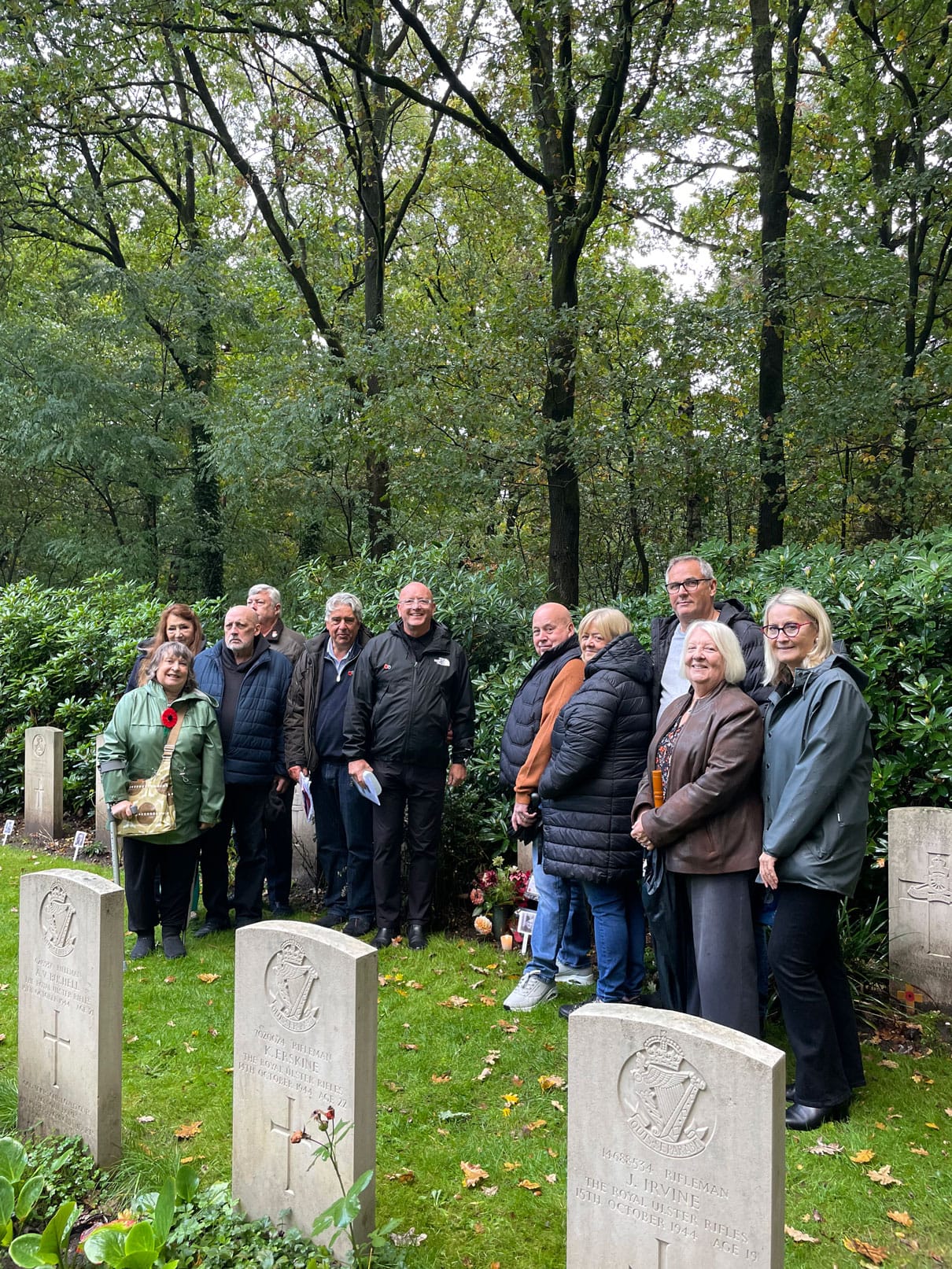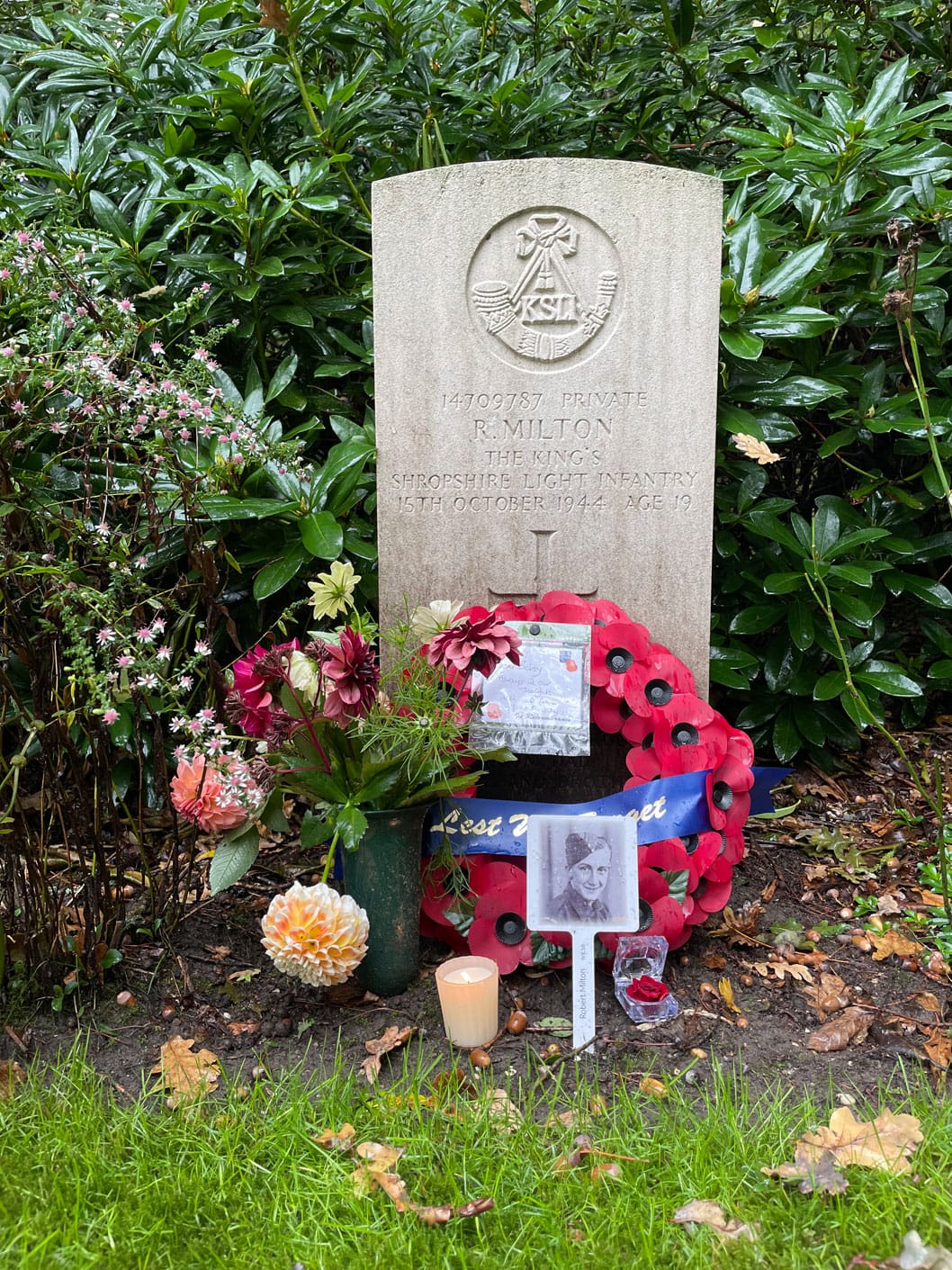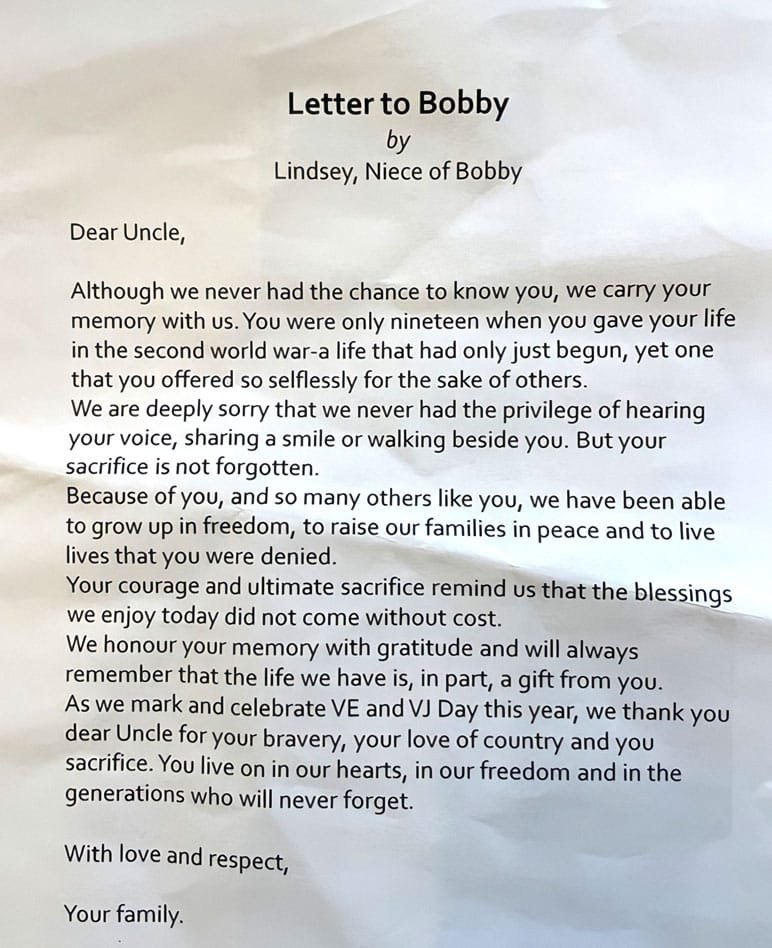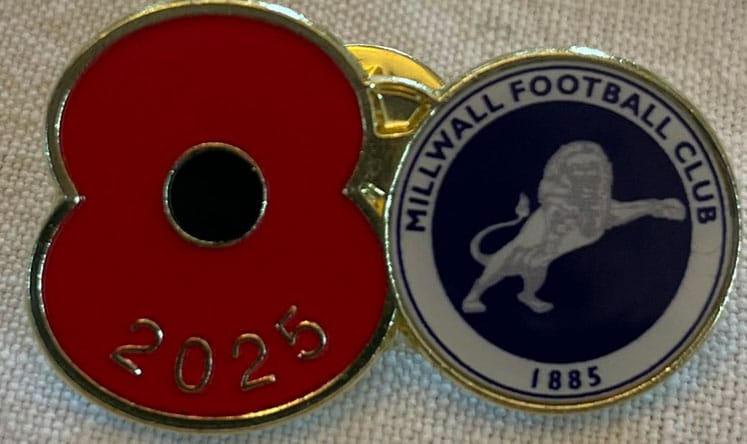Saxton Geoffrey
Saxton | Geoffrey Hurndall
First names
Geoffrey Hurndall
Age
32
Date of birth
15-12-1913
Date of death
13-02-1945
Service number
T/133785
Rank
Lance Corporal
Regiment
Royal Army Service Corps
Grave number
II. D. 2.

Geoffrey Hurndall Saxton
Geoffrey Hurndall Saxton

Grave Geoffrey Saxton
Grave Geoffrey Saxton
Biography
Geoffrey Hurndall Saxton was 32 when he was killed in action on 13 February 1945. He was a driver in the Royal Army Service Corps (Service Number T/133785). He was initially buried on the premises of M. de Groot at Boxmeerseweg C 40a St. Anthonis and then re-interred 21 May 1947 in grave II.D.2 in the CWGC Cemetery at Overloon. The inscription on his grave reads: “One day we shall understand. Elsie and children.”
Family background
Geoffrey was the son of Ernest Francis and Kathleen Saxton, though it is likely that he was adopted by them. He was the husband of Elsie May Saxton of North Fambridge, Essex. Ernest Francis Saxton married Kate Maria Hurndall in 1909 in the Pancras district of London.
Ernest Francis Saxton was born on 4 March 1883 in the Fairfield area of West Derby in Liverpool. He was the son of William Saxton and Mary Frances Owen who had married in West Derby, Liverpool in 1878. They were living at 11 Freehold Street at the time of his baptism on 1 April 1883 and his father was working as a Book-keeper. William was born in 1846 in Liverpool and Mary in 1858 in Birkenhead.
William and Mary had eight children in total, most born in West Derby, as follows: Elsie Violet 1879, William Herbert 1881, Ernest Francis 1883, Frederick Charles 1884, Hilda Abigail 1887, Mary Constance 1888, Eveline Beatrice 1889 and Arthur Cecil 1891.
In 1891 William and Mary were living at 57, Moor Lane, Great Crosby, West Derby, Lancashire. Willilam was working at a Collector of Poor Rates. All their children were with them except Arthur who was not yet born. Present too was Annie Thomas, a 22 year old servant born in Everton and Marion Wilson, a 48 year old single woman who was visiting the family. She was working as a head nurse at a hospital.
The Liverpool Daily Post of 9 July 1900 reported that Ernest F Saxton had received the Elementary Division 1st Class Certificate of the Church Sunday School Teachers’ Examinations. He was from the Church of St. John the Divine, Fairfield, Liverpool.
By 1901 Ernest’s mother, Mary F Saxton had died. His father was now living at 4 Freehold Street, West Derby with six of his children. Neither Ernest nor Frederick were living at home.
It seems that Ernest had moved to London as he was living at 22, Villa Road, Lambeth. He was working as a Civil Service Clerk and was a boarder in the household of Charles BP and Ellen F Bott. Charles was a printer born in Wiltshire in 1860 while Ellen was born in 1859 in Bayswater. With them was their son Claude CF Bott born in 1884 in Clapham who was a Ship Broker’s Clerk and their daughter Constance M Bott born in 1886 in Dulwich who was a student. Three other male boarders were present: Otto Fast born 1875 in Germany who was a Bank Clerk, Charles E Hutchinson born 1878 in Durham who was a Surveyor & Draftsman and Hugo A Hoffstaedter who was born in 1882 in Germany and was living on his own means.
Kate Maria Hurndall was born on 20 October 1860 in Paddington, London. She was the daughter of Henry Hurndall and Catherine Hurndall (nee McCaffrey). Henry was born in 1827 in Bushey, Hertfordshire and Catherine was born in 1830 in Ireland. In 1861 Henry and Catherine were living at 25, Charles Mews, Paddington, Kensington. Henry was working as a Coachman – domestic servant. With them were their daughters, Elizabeth S Hurndall, born 1859 and Kate M Hurndall born 1860 – both born in Paddington.
By 1871 Henry and Catherine were living at Porchester Gardens Mews, Paddington, Kensington with Elizabeth and Kate. Henry was still a coachman.
Henry Hurndall died on 24 March 1879. His address at the time was 2 Princes Mews, Princes Square, Bayswater. However, by June, Catherine had moved to 149 Southwark Bridge Road and was still there in 1881. Both her daughters were with her and were working as teachers in a public school.
Catherine Hurndall died on 1 February 1890. She had previously been living at 3 Herbert Road, Stockwell but had recently been living at Clifton Villas, Longley Road, Tooting. Kate Maria Hurndall was also living at Clifton Villas at the time.
By 1891 Kate Hurndall was shown as a Lodger, but with no head of household, at 12, Grafton Square, Clapham, Wandsworth, London. She was still working as a school teacher. With her was Jane Overend, born 1863 from Liverpool who was also a lodger and another school teacher. Present too were two female visitors born in Scotland and living on their own means. They were 36 year old Elsie Milne and 29 year old Mary King. By 1901, Kate Hurndall was the head of a household at 142, Amesbury Avenue, Streatham, Wandsworth. She was still a School Teacher and Jane Overend was also still there as a boarder and also still a school teacher.
When Kate Hurndall married Ernest Francis Saxton in 1909, she was 49 and he was just 26.
The London Evening Standard of 01 October 1910 reported that Ernest F Saxton of the Estate Duty Office was one of a number of men who had served upwards of 8 years as clerks of the 2nd division and were now promoted to 2nd class clerkships of the 1st division.
In 1911 Ernest and Kate were living at 209 Barcombe Avenue, Streatham Hill S W, Wandsworth Borough. Ernest was working at a 2nd class clerk. Jane Ann Overend, aged 49, was still living with them and was described as a “certificated teacher retired on breakdown pension.” Her birth place was more specifically described as Fairfield, Liverpool, the same as Ernest. This link may have something to do with how Ernest and Kate met. It was noted that Ernest and Kate had no children at his time.
It seems that Ernest served in WW1 as a Lieutenant in the Huntingdonshire Cyclist Battalion, attached to the Liverpool Regiment.
By 1921, Ernest and Kate were living at 111, Selsdon Road, Croydon, Surrey. Ernest was working as a Civil Servant (Clerk) in the Estate Duty Office at Somerset House. Two visitors were present: Ernest’s brother Frederick Charles Saxton, born 1884 in West Derby, who was working as a Bank Cashier for the London County & West Parish Bank of Belper, Derbyshire. The other visitor was a boy named George Leslie Davidson who was born in Marylebone, London. He was aged 7 years and 6 months, so born around the end of 1913 or the beginning of 1914. It was stated that both his parents were dead. Also present was a servant, Emma Jane Ingle aged 41 from Rochdale, Lancashire. The census indicated that Ernest and Kate had no children, yet Geoffrey Hurndall Saxton was born on 15 December 1913 and might have been expected to be present. He couldn’t be found living elsewhere and no birth record for anyone of that name could be found. Kate Maria Saxton would have been 53 in 1913, meaning it is rather unlikely that she was his birth mother. It is possible that he may have been adopted by Ernest and Kate and given a completely new name.
George L Davidson, who was visiting Ernest and Kate in 1921, was himself born on 15 December 1913 at the Queen Charlotte Hospital in Marylebone, London. His mother was named as Elizabeth Davidson, a Kitchen Maid of 21 Talbot Street, Mansfield Notts. No father’s name was given. It seems more than a co-incidence that George and Geoffrey had the same birth dates. It is likely that it was George who was adopted by Ernest and Kate – but it is rather odd that his first name was changed from George to Geoffrey.
It is thought that Geoffrey’s father may possibly have been Ernest’s brother, Frederick Charles Saxton, who was also visiting Ernest and Kate in 1921. Frederick had worked in a bank before WW1, first as an apprentice in the Isle of Man in 1901 and then as bank clerk while living back with his widowed father, sisters Elsie and Eveline and brother Arthur in Liverpool in 1911.
Military career
Geoffrey enlisted at Southend on Sea on 3 January 1940 in the Royal Army Service Corps. His occupation as a Motor Driver meant he was suited for the work of the RASC. He enlisted in the Territorial Army for the duration of the war. His rank was that of Driver. He was described as being 5ft 9in tall with a fresh complexion, blue eyes and brown hair and weighed 143lbs. He was declared fit for general service at home and abroad. At this time, his wife’s address was given as c/o Mrs N Lewis, The Flat, 784 St Alban’s Road, Harston, Watford, Herts. However, Geoffrey’s own address was still given as Elmtrees Farm. It may be that Elsie had returned home to get support from her family while Geoffrey was away.
The Royal Army Service Corps was a Corps of the British Army responsible for land, coastal and lake transport, air despatch, barracks administration, the Army Fire Service, staffing headquarters’ units, supply of food, water, fuel and domestic materials such as clothing, furniture and stationery and the supply of technical and military equipment. They trained at Aldershot.
They had the additional responsibility of transporting supplies as far as the front line, where individual units took over responsibility. The corps were also responsible for the administration and maintenance of barracks and quarters. They did not issue or maintain weapons, military equipment or ammunition, as this was the responsibility of the Royal Army Ordnance Corps. However, they did transport ammunition from Base Ordnance Depots to Forward Ammunition Points. It was also their task to transport and distribute Petrol, Oil and Lubricants. The Corps was highly mechanized by the beginning of the Second World War. It lost a large number of vehicles with the evacuation of the British Expeditionary Force and it took a couple of years to make good the losses.
Geoffrey initially spent a week undergoing infantry training with the Argyll and Southern Highlanders at Stirling in Scotland before returning to his unit on 10 January 1940.
He was posted to 903 Company on 2 February but is recorded in a casualty report as having fallen dangerously ill on 5 February 1940 while based in the UK. His service record suggests that he was posted to 1 Depot Battalion from hospital on 24 April 1940. He was then posted to 30 Station Transport Company on 17 August 1940. On 6 January 1942 he was appointed to the rank of Acting Paid Lance Corporal, then Acting Unpaid Corporal on 14 February 1942 and promoted to War Substantive Corporal on 15 May 1942.
He remained with 30 Station Transport Company until 8 October 1942 when he was posted to 71 C.M.T Mixed Transport Company. He was posted to 580 C.M.T. on 1 February 1943 until 29 July 1943. Just before he left this unit he undertook training in Fire Fighting for five days. As mentioned above, the RASC were responsible for the Army Fire Service. He was then posted to 635 Divisional Composite Company, then quickly through two other postings to 1653 Medium Regiment Platoon on 15 December 1943.
On 21 January 1944 his rank reverted to Driver at his own request. It is not known why he chose to drop back down to this rank. On 5 May 1944 he was posted to 1653 Artillery Platoon. On 28 June 1944 he embarked for France with this platoon as part of 21st Army Group.
The RASC was organised to support individual regiments, sometimes infantry and sometimes other types of Regiments. 1653 Medium Regiment Platoon will have been supporting a Medium Artillery Regiment while 1653 Artillery Platoon will also have been supporting an Artillery Regiment. However. His service record makes it clear that his Platoon was part of the support for the 21st Army Group.
The 21st Army Group was a British headquarters formation formed during the Second World War. It controlled two field armies and other supporting units, consisting primarily of the British Second Army and the First Canadian Army. Established in London during July 1943, under the command of Supreme Headquarters Allied Expeditionary Force, it was assigned to Operation Overlord, the Western Allied invasion of Europe, and was an important Allied force in the European Theatre. At various times during its existence, the 21st Army Group had additional British, Canadian, American, and Polish field armies or corps attached to it. The 21st Army Group operated in Northern France, Luxembourg, Belgium, the Netherlands and Germany from June 1944 until August 1945, when it was renamed the British Army of the Rhine.
Given his role, Geoffrey will have played a key part in ensuring the troops were supplied and fed as they pushed through North West Europe from D-Day to Germany.
Geoffrey Hurndall Saxton died on 13 February 1945. This was on the same day as Driver Arthur Reuben Murkin, aged 24, also of the Royal Army Service Corps. He was initially buried alongside him at the premises of M. de Groot at Boxmeerseweg C 40a St. Anthonis. He was then re-interred alongside him at Overloon. This raises the possibility that they died in the same incident.
Given the date of their deaths and where they were initially buried it is likely that they were killed during Operation Veritable involving XXX Corps and the 3rd Canadian Infantry Division which in turn were part of the 21st Army Group. This was also known as the Battle of the Reichswald and was the northern part of an Allied pincer movement that took place between 8 February and 11 March 1945 during the final stages of the war.
The operation started with XXX Corps advancing through the Reichswald while the 3rd Canadian Infantry Division, in amphibious vehicles, cleared German positions in the flooded Rhine plain. The Allied advance proceeded more slowly than expected and at greater cost as the American southern pincer, Operation Grenade, was delayed by the deliberate flooding of the Ruhr River by German forces which allowed them to be concentrated against the Commonwealth advance.
The Royal Army Service Corps would have had responsibility for keeping troops supplied in what would have been very challenging logistical difficulties during this operation. In the case of Geoffrey’s platoon, he will have been supplying an Artillery Regiment.
Geoffrey is commemorated on a war memorial at Holy Trinity Church, North Fambridge.
His father, Ernest Saxton, died on 27 January 1946 just under a year after his son. He was still living at 14 Haling Park Road.
In 1964, a long time after Geoffrey’s death his wife, Elsie M Saxton, married Norman T Davey in Maldon Essex. She died in Chelmsford in 2003.
Sources and credits
From FindMyPast website: Civil and Parish Birth, Marriage and Death Records; England Census and 1939 Register Records; Electoral Rolls; Military Records
Birth record of George Leslie Davidson
Wikipedia: Royal Army Service Corps
British Military History website: Royal Army Service Corps
Geoffrey Hurndall Saxton’s Service Record.
Sue Reynolds for the photo
Assistance from Danny Saxton, Geoffrey’s great grandson
Research Elaine Gathercole




